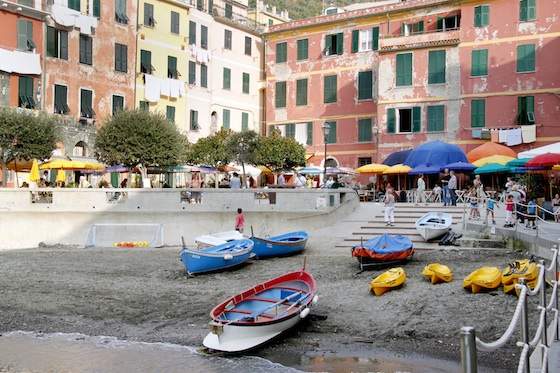- MENU
- HOME
- SEARCH
- WORLD
- MAIN
- AFRICA
- ASIA
- BALKANS
- EUROPE
- LATIN AMERICA
- MIDDLE EAST
- United Kingdom
- United States
- Argentina
- Australia
- Austria
- Benelux
- Brazil
- Canada
- China
- France
- Germany
- Greece
- Hungary
- India
- Indonesia
- Ireland
- Israel
- Italy
- Japan
- Korea
- Mexico
- New Zealand
- Pakistan
- Philippines
- Poland
- Russia
- South Africa
- Spain
- Taiwan
- Turkey
- USA
- BUSINESS
- WEALTH
- STOCKS
- TECH
- HEALTH
- LIFESTYLE
- ENTERTAINMENT
- SPORTS
- RSS
- iHaveNet.com: Vacation Travel

Italy's Cinque Terre Revisited
by Rick Steves
A freak rainstorm hit the Cinque Terre, an idyllic string of five Italian Riviera towns. Within four hours, the region got 22 inches of rain -- a third of an average year's total. While three of the towns went virtually undamaged, the other two -- Monterosso and Vernazza -- were devastated. Buried under nearly 10 feet of mud that slid down from the hillsides, the towns were left without water, electricity, or phone connections. It was a day residents will talk about for the rest of their lives.
I returned to the Cinque Terre to check in on the rebuilding efforts and visit old friends. I traveled there, on the six-month anniversary of the flood, and returned again in summer. Both times, I was amazed by the progress and moved by the locals' devotion to restoring their little chunk of Mediterranean paradise.
The destruction mostly occurred along former ravines, where, long ago, streams ran through the towns. In the last century, the ravines were covered with streets, and the water drained through canals under the pavement.
During the flood, debris from the landslides filled up these canals, clogging them like congested arteries. Water pressure from drain pipes below caused streets to explode upward. Medieval wells in basements became geysers. Trees, furniture, and cars plowed through the city. Rivers of raging mud rampaged down the streets, stranding people and ultimately leaving shops and restaurants on the main streets of old Monterosso and Vernazza buried.
While the two towns incurred about the same amount of damage, they've come back at their own pace. Monterosso, a bigger town with better access to the outside world, was essentially back up and running by spring.
Its streets have been repaired with big new grates, allowing rushing water to flow freely underneath and down to the sea without taking businesses and dreams with it. Restaurants in affected areas opened for business after they had been gutted and rebuilt with new stoves and equipment, then furnished with fresh tables, chairs, plates, and bottles of wine lining the walls. Young locals were having rock-removal parties on the beach, clearing out flood debris in an effort to make the beach more inviting for tourists.
Monterosso's church has been restored and serves not just as a place of worship, but also as a reminder of the dedication of the townspeople, who rushed in during the flood to rescue the church's statues by moving them through raging waters to higher points. Over the next few months, volunteers would come to the church and lovingly polish the candlesticks.
Vernazza, smaller and more isolated, has taken longer to bounce back. Strolling down its main drag six months to the day after the flood was like seeing an old friend who had changed dramatically. What has long been the best nightspot in town, the Blue Marlin Bar, was an empty concrete shell.
Nostalgic, I had lunch in Piva's restaurant, where I first ate when visiting as a student in the 1970s. Piva, who cooked an amazing seafood risotto then as now, has long been the town troubadour. Many nights, when the cooking was done, he'd pull out his guitar and lead his happy diners in song. After showing me the new post-flood ovens and stoves in his kitchen, he pulled out his well-worn guitar -- a trace of mud still caked on its neck -- and said, "In this restaurant only my guitar survived the flood."
Returning to Vernazza several months later, I saw some remarkable changes. The center of town had sprung back to life. The beach was a delight, the small boats bobbed lazily at their buoys, and the restaurants were thriving. The Blue Marlin Bar had reopened, buzzing with customers enjoying home-cooked food, drinks, and live piano music. And the wonderful hiking trails, connecting the five Cinque Terre towns, were mostly open and better than ever, as resident stone masons have skillfully rebuilt the stone walls and bridges that were washed out.
Though there is still work to be done, life on the Italian Riviera is, once again, very good.
A particularly happy moment for me was taking a late-night walk through Monterosso, down streets and through parks that were once filled with mud. On hot summer days, all across the Mediterranean, sweltering piazzas come to life as families come out late at night. At this particular scene, with images of the flood still vivid in my mind, I capped my day with a thankful smile.
Sleeping:
In Monterosso, Hotel Villa Steno features great view balconies, panoramic gardens, and a roof terrace with sun beds (splurge, www.villasteno.com). In Vernazza, Albergo Barbara has simple rooms overlooking the harbor square (moderate, www.albergobarbara.it).
Eating:
L'Alta Marea in Monterosso serves fresh seafood, including fish ravioli and huge crocks of steamed mussels (Via Roma 54). Vernazza's Trattoria Gianni is an old standby for natives and tourists who appreciate the best prices on the harbor.
Tourist Information:
www.prolocomonterosso.it (for Monterosso); http://savevernazza.com (for the latest on Vernazza and its recovery).
Article: Copyright ©, Tribune Media Services Inc.
Vacations & Travel "Italy's Cinque Terre Revisited"